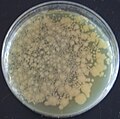Genetically modified bacteria
Genetically Modified Bacteria are bacteria whose genetic material has been altered through genetic engineering techniques. These modifications are made to give the bacteria new capabilities or to enhance their existing functions. Genetically modified (GM) bacteria have applications in medicine, industry, agriculture, and environmental management.
Overview[edit]
Genetic modification involves the manipulation of an organism's DNA to achieve desired traits. In bacteria, this can be accomplished through various methods such as transformation, transduction, and conjugation. These techniques allow the introduction of new genes or the alteration of existing genes in the bacterial genome.
Applications[edit]
Medicine[edit]
In medicine, GM bacteria are used for the production of pharmaceuticals, vaccines, and as vectors for gene therapy. For example, Escherichia coli has been engineered to produce insulin, human growth hormone, and other therapeutic proteins. Additionally, GM bacteria are being explored as a means to directly treat diseases by delivering therapeutic agents to specific sites in the body.
Industry[edit]
In the industrial sector, genetically modified bacteria play a crucial role in biotechnology and bioengineering. They are used in the production of enzymes, biofuels, and bioplastics. These bacteria can be engineered to break down pollutants, offering a sustainable alternative to traditional chemical processes.
Agriculture[edit]
In agriculture, GM bacteria are used to promote plant growth, enhance nutrient uptake, and provide resistance to pests and diseases. For example, bacteria that fix nitrogen can be modified to increase their efficiency, benefiting crops that rely on nitrogen as a key nutrient.
Environmental Management[edit]
Genetically modified bacteria are also employed in environmental management through bioremediation. These bacteria can be engineered to degrade pollutants in soil and water, such as oil spills and heavy metals, thereby mitigating environmental damage.
Safety and Regulation[edit]
The use of genetically modified bacteria raises safety and ethical concerns, including the potential for unintended environmental impacts and horizontal gene transfer to non-target organisms. As a result, the development and release of GM bacteria are subject to strict regulatory frameworks that assess their safety and environmental impact.
Research and Development[edit]
Ongoing research in the field of microbial genetics and biotechnology continues to expand the applications of genetically modified bacteria. Advances in CRISPR-Cas9 and other gene-editing technologies are enabling more precise and efficient modifications, opening new possibilities for their use in various fields.
See Also[edit]
References[edit]
<references/>
This article is a Biotechnology stub. You can help WikiMD by expanding it!
-
Genetically modified bacteria under ambient light
-
Genetically modified bacteria under ultraviolet light
-
Genetically modified bacteria in a laboratory setting
Ad. Transform your life with W8MD's Budget GLP-1 injections from $75


W8MD offers a medical weight loss program to lose weight in Philadelphia. Our physician-supervised medical weight loss provides:
- Weight loss injections in NYC (generic and brand names):
- Zepbound / Mounjaro, Wegovy / Ozempic, Saxenda
- Most insurances accepted or discounted self-pay rates. We will obtain insurance prior authorizations if needed.
- Generic GLP1 weight loss injections from $75 for the starting dose.
- Also offer prescription weight loss medications including Phentermine, Qsymia, Diethylpropion, Contrave etc.
NYC weight loss doctor appointmentsNYC weight loss doctor appointments
Start your NYC weight loss journey today at our NYC medical weight loss and Philadelphia medical weight loss clinics.
- Call 718-946-5500 to lose weight in NYC or for medical weight loss in Philadelphia 215-676-2334.
- Tags:NYC medical weight loss, Philadelphia lose weight Zepbound NYC, Budget GLP1 weight loss injections, Wegovy Philadelphia, Wegovy NYC, Philadelphia medical weight loss, Brookly weight loss and Wegovy NYC
|
WikiMD's Wellness Encyclopedia |
| Let Food Be Thy Medicine Medicine Thy Food - Hippocrates |
Medical Disclaimer: WikiMD is not a substitute for professional medical advice. The information on WikiMD is provided as an information resource only, may be incorrect, outdated or misleading, and is not to be used or relied on for any diagnostic or treatment purposes. Please consult your health care provider before making any healthcare decisions or for guidance about a specific medical condition. WikiMD expressly disclaims responsibility, and shall have no liability, for any damages, loss, injury, or liability whatsoever suffered as a result of your reliance on the information contained in this site. By visiting this site you agree to the foregoing terms and conditions, which may from time to time be changed or supplemented by WikiMD. If you do not agree to the foregoing terms and conditions, you should not enter or use this site. See full disclaimer.
Credits:Most images are courtesy of Wikimedia commons, and templates, categories Wikipedia, licensed under CC BY SA or similar.
Translate this page: - East Asian
中文,
日本,
한국어,
South Asian
हिन्दी,
தமிழ்,
తెలుగు,
Urdu,
ಕನ್ನಡ,
Southeast Asian
Indonesian,
Vietnamese,
Thai,
မြန်မာဘာသာ,
বাংলা
European
español,
Deutsch,
français,
Greek,
português do Brasil,
polski,
română,
русский,
Nederlands,
norsk,
svenska,
suomi,
Italian
Middle Eastern & African
عربى,
Turkish,
Persian,
Hebrew,
Afrikaans,
isiZulu,
Kiswahili,
Other
Bulgarian,
Hungarian,
Czech,
Swedish,
മലയാളം,
मराठी,
ਪੰਜਾਬੀ,
ગુજરાતી,
Portuguese,
Ukrainian




